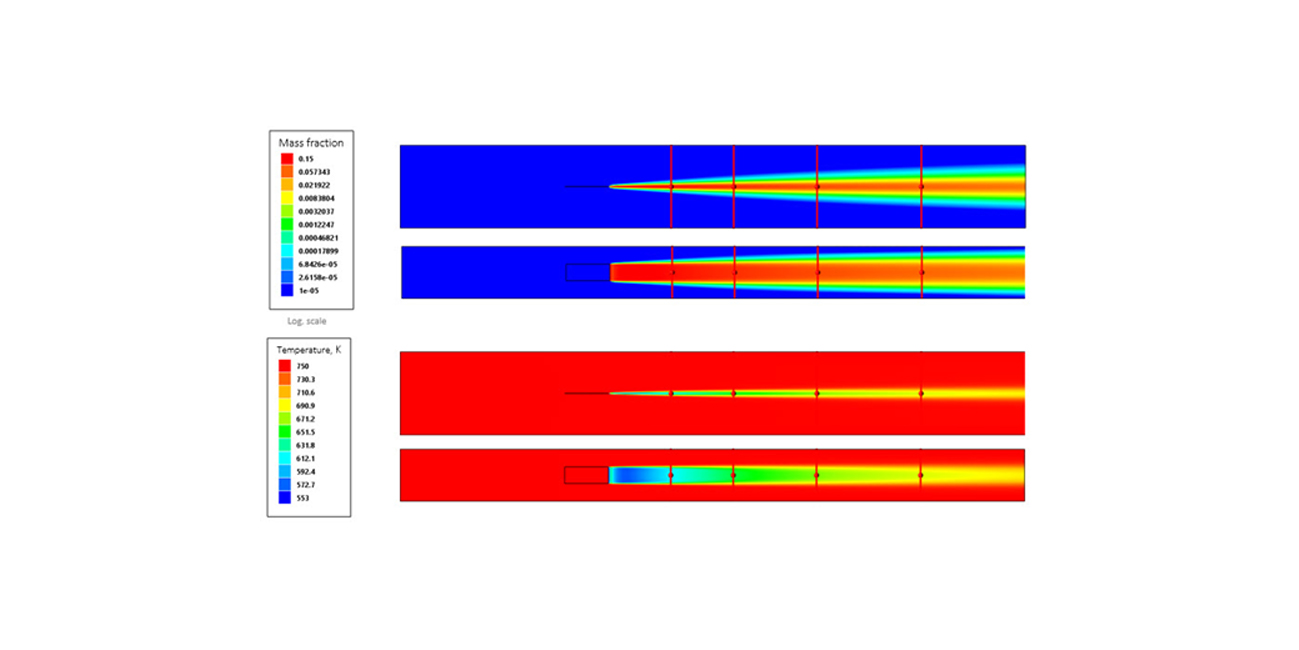В программном комплексе FlowVision была разработана методика моделирования испарения жидкого топлива с использованием Эйлерова подхода взаимодействия сплошной и дисперсной сред.
Созданная методика была верифицирована по результатам численного исследования на основе экспериментальных данных задачи испарения керосина, поступающего с высокоскоростным набегающим потоком воздуха с пленочного участка распылителя в канале предварительного смешивания для камер сгорания газовых турбин.
В работе в качестве несущей фазы рассматриваются воздух и пары керосина, а в качестве дисперсной фазы - жидкий керосин. На основе рассчитанного распределения капель керосина определяется значимый параметр, характеризующий мелкость распыла - средний саутеровский диаметр. Полученные по результатам расчета скорость испарения и средний саутеровский диаметр капель топлива в разработанной модели хорошо согласуются с экспериментальными данными.
При проведении экспериментов варьировались температура и давление воздуха. При этом, по сравнению с расчетными данными, получено более сильное влияние на испарение керосина температуры воздуха, чем давления. Зависимость от давления проявляется при учете соответствующих ему изменений свойств жидкого топлива. Также отмечено, что важным параметром при испарении является начальная температура топлива. Данная тенденция подтверждается в результатах проведенного в настоящей работе численного моделирования испарения керосина.
Andrey A. Aksenov, Sergey V. Zhluktov, Vladimir S. Kashirin, Marina L. Sazonova, Sergey G. Cherny, Ilia V. Zeziulin, Maria D. Kalugina Three-dimensional Numerical Model of Kerosene Evaporation in Gas Turbine Combustors // Supercomputing Frontiers and Innovations 2023, Vol. 10, No. 4
Скачать (статья на английском языке): PDF (1890КБ)
A three-dimensional model of the multiphase flow based on the Eulerian–Eulerian approach was implemented using the FlowVision CFD package and, on this basis, a numerical algorithm for study of evaporation of liquid fuel was developed.
The created high-performance complex for the carrier and dispersed phases interaction simulation was validated against the well-studied experimental problem of the evaporation and mixing of kerosene emerging from a flat pre-filming airblast atomizer for gas turbine combustors. In this work, the carrier phase is supposed to be air and kerosene vapors, and the dispersed phase is selected as liquid kerosene. Based on the calculated kerosene evaporation drops distributions, an important parameter that characterizes the spray fineness, Sauter mean diameter, is determined. Numerically calculated in the developed model the evaporation rate and Sauter mean diameter of fuel droplets agreed well with the experimental data. In famous works, the air temperature and pressure varied during the experiments. At the same time, in comparison with the calculated data, a stronger influence on the kerosene evaporation was obtained by air temperature than pressure. The dependence on pressure can be seen in the case of taking into account the corresponding changes in the liquid fuel properties. It is also noted that the initial fuel temperature is an important parameter for evaporation. This can be seen in the results of the kerosene evaporation numerical simulation carried out in this study.
© The Authors 2023. This paper is published with open access at SuperFri.org (https://superfri.org/index.php/superfri)

